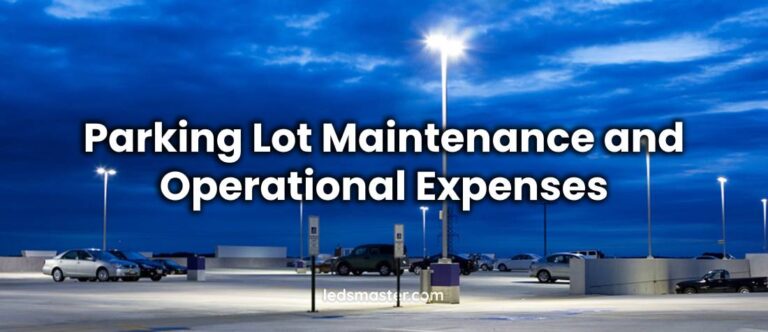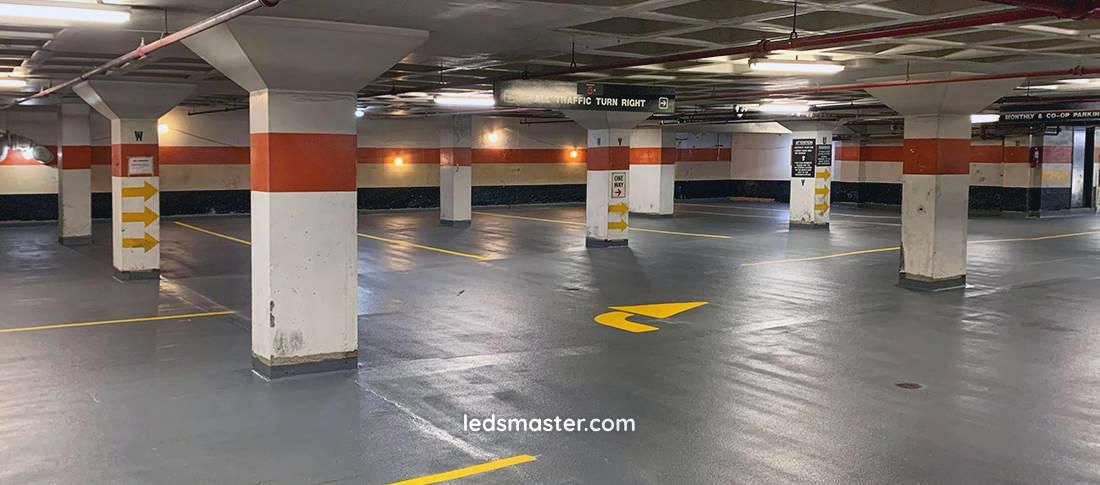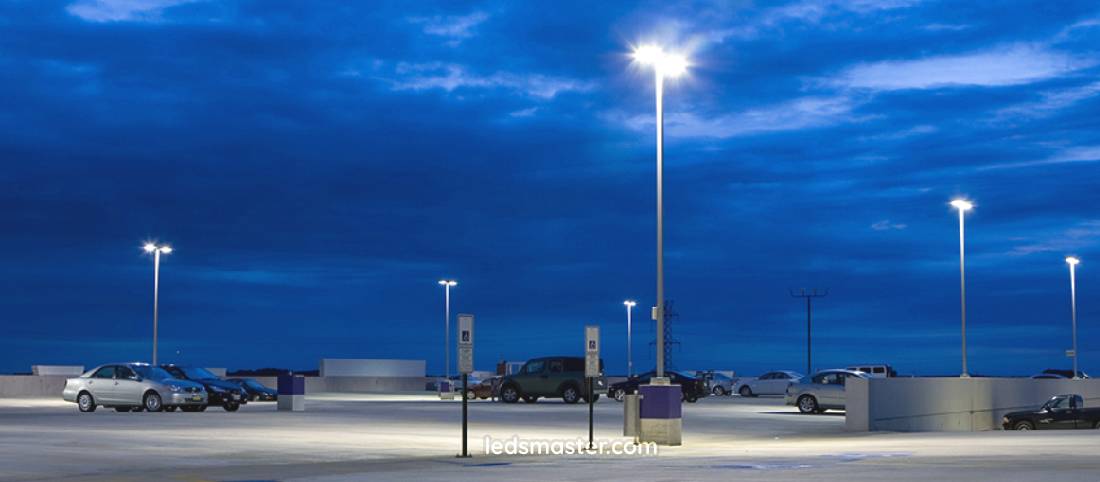
From bustling shopping centers to serene parks, the presence and management of parking facilities can significantly impact both convenience and accessibility. As urban areas continue to expand, the challenge of managing parking costs while meeting community needs becomes increasingly relevant.
Get your complimentary lighting design today
Well-lit parking areas deter crime, enhance visibility, and improve the overall aesthetic of the space. However, the costs associated with parking lot lighting can vary widely based on several factors, including the type of lighting, installation costs, maintenance expenses, and energy consumption.
| Lighting Type | Initial Cost | Lifespan | Energy Efficiency | Maintenance Costs | Brightness | Color Rendering |
|---|---|---|---|---|---|---|
| LED Lighting | $150 – $400 per fixture | 25,000 – 50,000 hours | Very high (up to 90% savings) | Low (infrequent replacements) | High (up to 130 lumens/watt) | Excellent (CRI > 80) |
| Metal Halide Lighting | $100 – $300 per fixture | 15,000 hours | Moderate | Moderate (bulb replacements every 2-3 years) | High (up to 115 lumens/watt) | Good (CRI 65-75) |
| High-Pressure Sodium (HPS) Lighting | $80 – $200 per fixture | 24,000 hours | Moderate | Moderate (bulb replacements every 2-4 years) | Moderate (up to 140 lumens/watt) | Poor (CRI 20-30) |
| Solar Lighting | $250 – $700 per fixture | 10,000 – 25,000 hours | Varies (depends on sun exposure) | Low (minimal maintenance) | Moderate (up to 100 lumens/watt) | Varies (depends on LEDs used) |
Table of Contents
ToggleLED (Light Emitting Diode) lighting has gained popularity in recent years due to its energy efficiency, longevity, and low maintenance requirements. LEDs consume significantly less energy compared to traditional lighting options, resulting in lower electricity bills. Additionally, they have a lifespan of up to 25,000 to 50,000 hours, which reduces the frequency of replacements. While the initial costs of LED fixtures can be higher than other lighting options, the long-term savings on energy and maintenance often justify the investment. The reduced environmental impact and the ability to provide bright, uniform light further enhance their appeal.
Metal halide lighting is a type of high-intensity discharge (HID) lighting that produces a bright, white light. It is commonly used in parking lots due to its excellent color rendering and ability to illuminate large areas effectively. However, metal halide fixtures tend to consume more energy than LED options, leading to higher ongoing operational costs. Although initial installation costs for metal halide lighting may be lower than for LED systems, the shorter lifespan—typically around 15,000 hours—means more frequent replacements and maintenance, ultimately increasing overall costs over time.
High-pressure sodium lighting is another type of HID lighting that is often used in outdoor applications, including parking lots. HPS fixtures produce a distinctive yellow light that is less visually appealing but is effective in illuminating large spaces. While HPS lights are relatively inexpensive to install and have a long lifespan of around 24,000 hours, they are less energy-efficient compared to LED lighting. Furthermore, the color rendering of HPS lighting is inferior, which can make it challenging for drivers and pedestrians to distinguish colors accurately. This limitation may pose safety concerns in certain situations, emphasizing the need for careful consideration of lighting choices.

Solar lighting is an innovative option that utilizes solar panels to harness energy from the sun. This sustainable approach reduces reliance on grid electricity and can lead to substantial savings on energy costs. The initial investment for solar lighting can be higher due to the cost of solar panels and battery storage systems, but the absence of ongoing electricity costs and minimal maintenance requirements make it an attractive option in the long run. Additionally, solar lights are often easy to install, as they do not require extensive electrical infrastructure. However, the effectiveness of solar lighting can be influenced by geographic location and seasonal changes, necessitating careful assessment of the area’s sunlight exposure.
When considering parking lot lighting, the initial installation costs encompass several factors, including equipment, labor, and site preparation. Equipment costs vary significantly based on the type of lighting chosen. For example, LED fixtures may have higher upfront costs but offer long-term savings, while traditional options like metal halide and HPS lights may be cheaper initially but result in higher operational expenses over time.
Labor costs also play a significant role in the overall installation expense. Hiring qualified electricians and contractors can lead to higher costs, but it ensures that the installation meets local codes and safety standards. Site preparation involves assessing the condition of the parking lot, making necessary repairs, and ensuring proper drainage and landscaping. Depending on the parking lot’s size and condition, site preparation can add considerable costs to the overall project.
After installation, ongoing operational costs become a primary concern for property owners. Energy consumption represents a substantial portion of these costs. The type of lighting selected significantly impacts energy usage. LED lighting, for instance, consumes far less electricity than traditional options, resulting in lower utility bills. Property owners should also consider the potential for energy price fluctuations over time, as rising electricity rates can further impact overall operational costs.
Maintenance and repair costs also contribute to the ongoing expenses of parking lot lighting. While LEDs require less maintenance than traditional lighting due to their longevity, all lighting systems require occasional inspections and repairs. For example, replacing burned-out bulbs, cleaning fixtures, and addressing electrical issues can incur additional costs. Property owners should budget for these expenses to ensure that parking lot lighting remains functional and effective over time.
Compliance with local regulations is another critical factor influencing the overall cost of parking lot lighting. Zoning codes and safety requirements may dictate specific lighting levels, fixture types, and installation methods. These regulations are designed to ensure safety for drivers and pedestrians, but they can also impact costs. Property owners may need to invest in higher-quality fixtures or additional lighting to meet local standards, resulting in increased expenses.
Environmental considerations are also becoming increasingly important in the context of parking lot lighting. Many municipalities are implementing regulations aimed at reducing light pollution and promoting energy-efficient practices. These regulations may require property owners to invest in specific lighting technologies, such as LEDs or solar lighting, which can impact initial costs. Understanding and navigating these regulations is essential for property owners to ensure compliance and avoid potential fines or delays in project approval.
The size of the parking lot is one of the most significant factors influencing lighting costs. Larger parking areas require more fixtures and greater installation effort, leading to higher overall expenses. Additionally, the layout of the parking lot, including the number of aisles and spaces, can affect the lighting design and the number of fixtures needed to achieve optimal illumination. As the size and complexity of the parking lot increase, so do the associated costs for both installation and ongoing operations.

The design and layout of the parking lot lighting system can also impact costs. A well-planned lighting design will ensure adequate coverage and minimize glare, enhancing safety for drivers and pedestrians. Factors such as the height of light poles, spacing between fixtures, and the direction of light all play a role in determining the effectiveness of the lighting system. Property owners may need to consult with lighting professionals to develop an optimal design, which can add to the initial costs but ultimately improve safety and visibility.
Geographic location and climate can significantly influence parking lot lighting costs. Areas with extreme weather conditions, such as heavy snowfall or high winds, may require more robust fixtures and additional protective measures to withstand the elements. In regions with abundant sunlight, solar lighting may be a more viable option, while areas with limited sunlight may necessitate alternative solutions, impacting initial and ongoing costs.
Local energy rates can also vary widely, affecting the long-term operational costs associated with parking lot lighting. Property owners should take these factors into account when assessing potential lighting options and calculating expected expenses.
The availability of materials and skilled labor can also impact parking lot lighting costs. Supply chain issues or shortages of specific lighting fixtures can lead to increased prices or delays in project timelines. Furthermore, labor costs can vary based on local market conditions, with areas experiencing high demand for skilled electricians and contractors potentially facing higher rates. Property owners should consider these factors when planning their lighting projects and budgeting for expenses.
A comprehensive cost-benefit analysis involves comparing different lighting options based on both initial and lifetime costs. While LED fixtures may have higher upfront costs, their energy efficiency and longevity can lead to substantial savings over time. In contrast, traditional lighting options like metal halide and HPS may seem more affordable initially but often result in higher operational expenses due to increased energy consumption and maintenance needs.
The impact of lighting on safety and security is another critical aspect of the cost-benefit analysis. Enhanced visibility in parking lots can reduce accidents and deter criminal activity, ultimately protecting both property and patrons. Evaluating the return on investment for different lighting options should consider both financial savings and the potential value added to the property through improved safety.
Calculating the return on investment (ROI) for parking lot lighting is essential for property owners looking to justify their expenditures. This calculation involves assessing both short-term and long-term savings from reduced energy consumption and maintenance costs. For example, transitioning from traditional lighting to LED fixtures can yield immediate savings on utility bills, while the longevity of LEDs translates to fewer replacements and repairs over time.
The value added to the property through improved lighting cannot be overlooked. Well-lit parking areas are more inviting for customers, which can enhance business traffic and overall satisfaction. Furthermore, properties with effective lighting may see an increase in property value, making the investment even more worthwhile.
Exploring funding options for parking lot lighting can significantly alleviate the financial burden associated with initial investments. Various federal and state programs offer grants and incentives for energy-efficient upgrades, including lighting. These programs aim to encourage property owners to adopt sustainable practices that reduce energy consumption and carbon footprints.
Utility companies often provide rebates for installing energy-efficient lighting systems. These incentives can help offset the initial costs, making it easier for property owners to transition to more efficient technologies like LEDs or solar lighting. Researching available grants and incentives can lead to substantial savings, enabling property owners to invest in high-quality lighting solutions.

Financing options are another avenue for funding parking lot lighting projects. Property owners can explore loans specifically designed for energy-efficient upgrades. Many financial institutions offer competitive interest rates and flexible repayment terms to support businesses looking to invest in sustainable solutions. Additionally, leasing arrangements may be available, allowing property owners to acquire lighting systems without the burden of upfront costs.
Public-private partnerships can also provide funding opportunities for larger projects. Collaborating with local governments or other
entities may lead to shared resources and funding, making it easier to implement comprehensive lighting solutions that benefit the community.
Effective budgeting is crucial for managing the costs associated with parking lot lighting. Property owners should incorporate both initial and ongoing expenses into their overall property management budgets. This includes planning for installation costs, energy consumption, maintenance, and compliance with local regulations. Long-term financial planning should also account for potential fluctuations in energy prices and maintenance needs, ensuring that property owners are prepared for future expenses.
Setting aside a dedicated budget for lighting upgrades can facilitate timely investments in energy-efficient technologies. This proactive approach allows property owners to stay ahead of potential issues, ensuring that their parking lot lighting remains functional and effective over time.
Parking lot lighting is a multifaceted investment that requires careful consideration of various factors, including initial and ongoing costs, types of lighting available, and funding opportunities. By evaluating different lighting options and understanding the implications of these choices, property owners can enhance safety and security in their parking areas while managing expenses effectively. With a thorough cost analysis and exploration of available funding options, property owners can make informed decisions that not only benefit their bottom line but also contribute to a safer environment for patrons and the community.